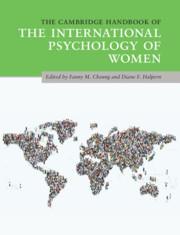Book contents
- The Cambridge Handbook of the International Psychology of Women
- The Cambridge Handbook of the International Psychology of Women
- Copyright page
- Dedication
- Contents
- Figures
- Tables
- Contributors
- Acknowledgments
- Section 1 The Underpinnings of Sex and Gender and How to Study Them
- Section 2 Developmental Perspectives of the International Psychology of Women
- 6 Sex Differences in Early Life
- 7 Gender and Adolescent Development across Cultures
- 8 Fertility, Childbirth, and Parenting
- 9 Three Ways that Aging Affects Women Differently from Men
- Section 3 Cognitive and Social Factors
- Section 4 Work and Family Issues
- Section 5 Inequality and Social Justice
- Section 6 Health and Well-Being
- Epilogue Some Final Thoughts and Take-Home Messages
- Index
- References
6 - Sex Differences in Early Life
A Cross-Cultural Perspective
from Section 2 - Developmental Perspectives of the International Psychology of Women
Published online by Cambridge University Press: 20 July 2020
- The Cambridge Handbook of the International Psychology of Women
- The Cambridge Handbook of the International Psychology of Women
- Copyright page
- Dedication
- Contents
- Figures
- Tables
- Contributors
- Acknowledgments
- Section 1 The Underpinnings of Sex and Gender and How to Study Them
- Section 2 Developmental Perspectives of the International Psychology of Women
- 6 Sex Differences in Early Life
- 7 Gender and Adolescent Development across Cultures
- 8 Fertility, Childbirth, and Parenting
- 9 Three Ways that Aging Affects Women Differently from Men
- Section 3 Cognitive and Social Factors
- Section 4 Work and Family Issues
- Section 5 Inequality and Social Justice
- Section 6 Health and Well-Being
- Epilogue Some Final Thoughts and Take-Home Messages
- Index
- References
Summary
Identifying and quantifying sex differences and similarities has been a central research question and fascinated scientists for centuries. A large body of work has been accumulated on this topic; however, conclusions are often drawn as if they are applicable across cultures even though studies have predominantly relied on Western samples. This chapter reviews cross-cultural literature on several early childhood sex differences in domains of development that have caught attention in the literature recently: gender-typed play, gender identity, and gender expression. We also offer an overview of possible influences on sex differences, including evolutionary, biodevelopmental (genetics, sex hormones, and immune factors), and sociocultural mechanisms (socialization and macro-cultural factors). Given that a cross-cultural perspective has often been lacking in this literature, this chapter reviews research on early gender development in males and females from Western populations as well as the non-Western populations wherever possible to highlight important cultural (in)consistencies.
Keywords
- Type
- Chapter
- Information
- Publisher: Cambridge University PressPrint publication year: 2020
References
Suggested Readings

Ivy Wong is an Assistant Professor in the Gender Studies Program at the Chinese University of Hong Kong. She is a gender development psychologist focusing on the expression of gender and its development at the intersection of socialization, cognition, and biology. She studies gender and sexuality across the life span. Her expertise includes gender-typed play, gender differences and similarities, sex segregation, gender socialization, gender variance, gender stereotypes, and sexual orientation. She is interested in bridging the gap between the West and other cultures in research on the psychology of gender. Wong was born in Mainland China, and moved to Hong Kong when she was 6. She was an undergraduate student at the University of Hong Kong. In her third year she obtained a scholarship to spend a full year at Cambridge University. Then she stayed on for an MPhil and PhD at Cambridge where she spent over five years. Wong is a full-blood Teochew, an ethnic Han group from southeastern China. She is fond of the Teochew dialect and traditions that her family is still able to keep.

Doug P. VanderLaan is an Assistant Professor in the Department of Psychology at the University of Toronto Mississauga, and a Collaborator Scientist in Child and Youth Psychiatry at the Centre for Addiction and Mental Health in Toronto. He has conducted community-based and clinical research on the development of gender expression as well as cross-cultural field studies on third gender individuals and sexual orientation in Samoa and Thailand. His other cross-cultural work on these topics has included collaborations with researchers in the Netherlands, Brazil, Japan, mainland China, and Hong Kong. VanderLaan was born in Canada in the Central/Toronto area. He attended college and graduate school in western Canada. VanderLaan has spent long periods of time in Japan, Samoa, and Thailand. He is of Sicilian and Dutch heritage.



